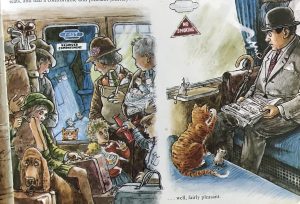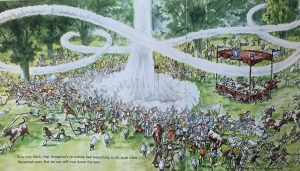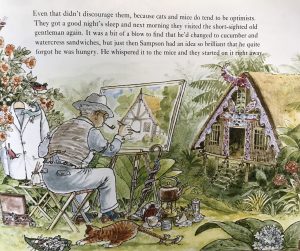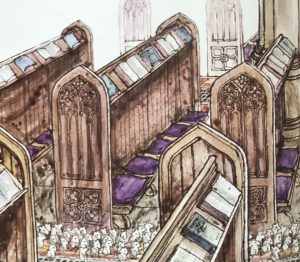Yes, the work in progress is humming along – I hope to have it all done and ready by late November, and launch officially at Miss Ruby’s Author Corral at Giddings, the first Saturday in December. In this excerpt, Minnie Vining and Mrs. Mary Bickerdyke have a good look at the Army hospital at Cairo, Illinois, in the first summer of the War Between the States.
At the same instant that Colonel Ennis bid them good evening, and took his departure, a very young woman in a calico dress which drooped hoop-less and looked by the hem of it to have been dragged through mud and other unclean matter, emerged from the nearest tent. Her apron was also similarly stained. She carried a bucket, which she set down as soon as she saw the other two women.
“Oh, merciful heavens, Mrs. Bickerdyke – you are here!” She was a very pretty, slender young woman, worn down to a thread and very near tears. “There is so much… and so many! I have done all that I can, and the contraband women and some ladies from Cairo are helping me, but there is only so much we can do with what little the Army can spare!”
“We are here now, Miss Vining and I,” Mary Bickerdyke enfolded the younger woman in a comforting embrace. “And four boxcar-loads of supplies – linens, food, spare cots and blankets and much else as well – which are on their way this very minute from the railyard. Colonel Ennis was good enough to put a trusty sergeant and a work party at our disposal. I do not wish to waste any time; show me the hospital, so that we may make plans to remedy the dire situation as soon as we are able. We may not be able to make improvements tonight,” Mary Bickerdyke added, with particularly resolute determination, “But at least, we will have a notion of what needs to be done.”
“Everything,” Miss Safford sniffed, and rubbed her eyes. “Everything … the poor souls lie in their own filthy bedding for hours, for lack of anything clean… It is all that I can do to bring them beef tea and a concoction of willow bark, steeped in hot water, or Peruvian bark for those poor souls with the ague and chills.”
“I have sufficient funds to hire laundresses,” Mary Bickerdyke replied. “And indeed – I do suppose that the contrabands in the camp that we passed would be happy enough to be hired for that task. Now show me the hospital.”
“All right,” Miss Safford gulped back her tears with a commendable effort. “This way … the convalescents are here, those who are still ill and not cleared by Surgeon-Major Frost to return to duty with their company. They help as much as they can, but they are hardly well themselves…”
The first tent was not so awful; filled with cots and bedrolls, most occupied by men, most in a state of dishevelment, or indeed, undress. At least half of them immediately dived for the cover of blankets or those garments they had set aside in the interests of comfort within the sweltering canvas roof, as the three women entered the tent.
“They are … unclothed!” Minnie hissed in a startled undertone. It was not that she had been completely unaccustomed to the sight of naked or near-naked males – after all, when she was a girl, her brothers and their friends would swim in the Charles, when the summer heat was particularly oppressive.
“They are,” Miss Safford acknowledged, in a welter of embarrassment and fanned her flushed face with her hand. “They are still recovering, and the heat is so pernicious. I … try to think of them in the same manner as creatures in the barnyard.”
“I was married to my husband Mr. Bickerdyke for twenty years, and have two sons,” Mrs. Bickerdyke replied, serenely. “I’m not seeing a particle of anything that I didn’t already know about.”
Minnie felt the same flush of embarrassment rising in her face. Well, she would have to get used to this. It was one thing to minister to her brothers when they were ill, and when they were dying – it would be another matter entirely to see to the needs of strange men; boys, really. Perhaps she would do her best to think of them as infants and small boys, in need of sisterly or motherly care. Miss Safford, so very young and unmarried, seemed to have found a means of coping by thinking of their patients as horses and cows.
Conditions in the other tents were … abominable. Hot, filled with the stench of vomit and feces, of unclean bodies and pungent male perspiration, stale air, and the indefinable odor of sickness. Minnie tried to hold her breath as much as possible. Mary Bickerdyke’s expression remained stern and resolute, even as Miss Safford’s expression reflected a degree of shamed embarrassment. But Mary Bickerdyke was unmoved, even serene.
“Rest easy, dear boys,” she said several times, as she leaned over a cot or a bedroll, smoothing the ragged, stained covering over the shivering form underneath. “Rest easy, for in the morning, we will fix things. You will be cared for as tenderly as if you were home with your dear mother. Rest easy, boys.”
It was fully evening when their tour of the hospital tents ended. The sun had gone down in the west, well below the edge of the levee, but the sky still retained the color of a bleached sea-shell in it, edged with pale apricot shreds of cloud. The distant sounds of drill and stamping feet echoed from the distant parade ground – a sound which had become so very familiar to Minnie, as familiar as the regular ticking of the old clock in Papa-the-Judge’s study, far away in Boston. Minnie took a deep breath of relatively fresher air. The compound of tents stretched away before the three women, many lit within by oil lamps, which gave the effect of a collection of Chinese paper lanterns. A scattering of campfires sent golden sparks up into the evening air, as ephemeral as golden fireflies. A bugle on the far side of camp sent a melancholy thread of music into the air. Minnie shivered a little, half in dread, half in anticipation – this would be her life for the foreseeable future, the regular tramp of marching feet, harsh male voices, the discordant music of drum and bugle.
In the open quadrant by the hospital tents a pile of crates and trunks steadily grew, as they were unloaded from Army wagons, under the profane direction of Sgt. Sullivan – at least, profane until he noted the presence of the three women.
“God save the mark, Ma’am.” He came to them, after bawling his last set of orders and commands over his shoulder to the half-dozen soldiers laboring to unload the last wagon. “Here we have all of your traps and treasure brought from the railway … was there anything more that you wish us to do?”
“There is,” Mary Bickerdyke studied the stack of barrels and scrap-wood crates, piled next to the nearest cook tent. “Those hogshead barrels … I would like eight or ten of the soundest and least damaged to be sawn in half, and the bungs stopped with plugs. Can you do that for me by tomorrow.”
“Of course, ma’am,” Sgt. Sullivan appeared to be mildly nonplussed. After a short hesitation, he ventured a question. “May I ask, ma’am – for what purpose?”
Mary Bickerdyke looked up at him as if this were the most obvious thing in the world, although even Minnie and Miss Safford were puzzled. “For bathing the sick, of course. Those barrels will make admirable tubs. Cleanliness is essential for these poor lads – and they are filthy-dirty. We’ll start on the morrow, ladies,” she added, with a look over her shoulder at the other two women. “Miss Safford, dear – have we a place to lay our heads down tonight, and perhaps have a bite of supper? Miss Vining and I are fatigued after a long day’s journey, and tomorrow will be very busy for all of us.”
“Oh, but of course,” Miss Safford replied, somewhat relieved that the tour of the dreadful ward tents was completed. “Colonel Prentiss very kindly allotted me a tent to myself and Free Mary … she is one of the contrabands who has been assisting me … we have been issued some camp cots, and Free Mary has been friends with the cook in the nearest camp kitchen. Besides, she brings me some good cornbread that her mother bakes … she and her sister and mother all escaped together and took refuge with the Army. Free Mary will have brought us all something to eat, I am certain.”
“Good,” Minnie replied, mildly relieved that she and Mary did have a place to sleep that night – as well as the prospect of a meal, although whether it would be edible or not was a matter of conjecture. She had a packet of food in the valise which she had brought with her from Galesburg; some slabs of bread and cheese, hardboiled eggs, and some cold fried chicken, in the event of the Army cook not being anywhere near as gifted as Mrs. Norris. She was as exhausted as she had ever been, after a long train journey, and contemplating the prospect of sorting out the hospital and it’s suffering patients on the morrow. She was so tired that she thought she could have lain down and slept soundly on a bare pallet, just as the soldiers did.






Recent Comments